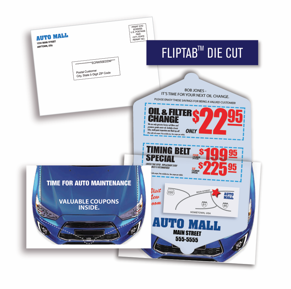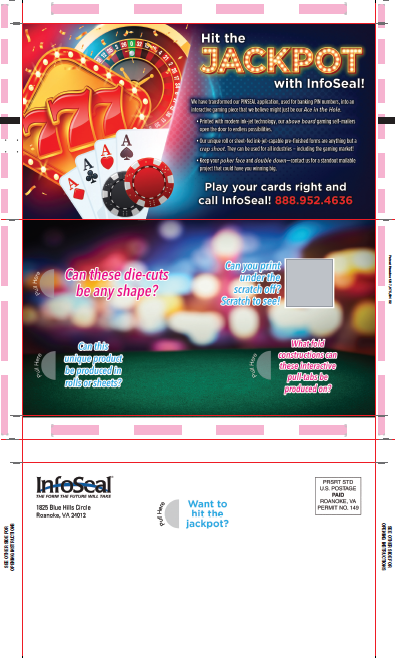Right now, you’re probably receiving a lot of political mail.
From the presidential race to your local elections, candidates are vying for your attention; it turns out that the mail is still one of the best ways to get it. After all, it’s hard to ignore an overflowing mailbox.
While it’s natural to think of direct mail pieces simply as single sheets or postcards, pressure seal forms work for a variety of clients, too.
Pressure seal refers to forms that are folded and sealed without liquid adhesive, usually with perforated edges to open. Think of the Z-folded sheets that you get from the DMV with your temporary driver’s license when you renew, or maybe what you receive when you register to vote.
While those are common and valid uses, the reality is that printers and distributors can do much more with pressure seal for forms and marketing purposes. Different printing capabilities can create the look and feel of a traditional envelope even, but with much less paper required – which is important for increasingly eco-minded end-buyers.
So, whether you’re an old pro in the print world and just want to learn a little more about this part of the industry, or you’re primarily a promotional hard goods and apparel distributor looking to get started on the print side of things, pressure seal – especially as it relates to direct mail – is a worthwhile solution to explore.
A Multifaceted Paper-Saving Medium
According to David Yost, general manager for InfoSeal in Roanoke, VA, the possibilities with pressure seal are virtually endless. That opens up all kinds of potential customer applications.
For instance, Yost says pieces currently available through InfoSeal have features like a scratch-off you would find on a lottery ticket. Using continuously fed inkjet printing, coupon numbers or codes can be printed behind the scratch off. InfoSeal recently executed such a solution for an automotive store customer. “We’ve also done this thing in the hospitality industry for cruises,” Yost says.
The use of inkjet printing has also created more affordable options. For example, “Coated papers are traditionally high-end applications, and with the advent of continuous-fed inkjet, they’re now able to print a much higher quality than they were in the past, which opens the door for a completely different look and feel of pressure seal,” Yost says. “In fact, you wouldn’t even think that these pieces are pressure seal documents when you look at them.”
Yost notes there are also products that disguise themselves as traditional envelopes. By printing on an additional backflap, the item looks like an envelope closure. But, he says, the key difference is the amount of paper required and there’s no stuffing involved, which saves time and resources.
“An inserter is going to run at somewhere between 10,000 and 20,000 pieces completed an hour,” Yost says. “Our mail pieces are at someplace between 60,000 and 80,000 documents an hour. That isn’t just a little shift. That’s a strategic shift in how you use your manpower.”
Aside from the time and output, he says, pressure seal can also save paper. In an age in which many clients want an eco-friendly option, that’s a valuable proposition.
“If you look at the square inches of an everyday throwaway envelope compared to the size of a pressure seal document, they’re almost the same,” Yost says. “However, you still have to put your content inside that envelope. In square inches of paper, our pressure seal document is the same as the envelope, but now you’re not inserting all that additional paper in most cases. It’s about 50% less paper in a pressure seal document compared to a single-ply mail stuffed inside a No. 10 window envelope.”

How To Spice Up Direct Mail Offerings
Use different materials and finishes in your direct mail solutions, says Summer Gould, an account executive for Neyenesch Printers. For example, she recommends elements like pull-tabs to reveal special messages, peek-a-boo windows, scratch-and-sniff, and even “infinite folds.”
“These fun items provide a message at each turn, and are usually folded through at least twice, as they drive curiosity,” says Gould, who’s also a board member for Printing Industries Association of San Diego and industry chair for the San Diego Postal Customer Council.
David Yost of InfoSeal touches on a similar point, saying that while a lot of people might simply jump to a Z-fold or single-fold pressure seal document, you can incorporate more folds, and even print on the outside of the “envelope” to entice the customer to open the piece. (end sidebar)
Consistent Choices
Proponents say that one of the most appealing things about pressure seal printing is that there’s consistent demand for it across a range of markets.
Aside from direct mail marketing campaigns, pressure seal solutions are commonly used by utility companies or other businesses for bills, invoices and other applications that are part of life year-round.
Primary purchasers of pressure seal forms span a gamut of end-markets, says Jessica Wenz, brand/product marketing manager for Coldwater, OH-based print supplier Wilmer.
Those include utility companies, which use the forms to send bills to customers, and financial firms, who need them for personal loan pre-approval information. Healthcare organizations deploy pressure forms to mail results, and educational institutions use them for report cards and fundraiser information. Government agencies? They send mailings like jury duty notices.
“Pressure seal sales are pretty steady throughout the year,” Wenz says. “Our largest month falls in January with new budgets for the year.”
While Wenz says that distributors can find success with pressure seal sales, especially when it comes to things like bills and forms rather than just marketing campaigns, they must plan out as much as possible when using some of the more eye-catching print techniques. “Adding holograms to stock takes time, so if they need a custom job done, they should plan a few months out to get it scheduled for the press and produced on time,” she says.
Fortunately, both Wenz and Yost say that the supply chain issues and paper shortages that plagued the early 2020s have mostly subsided. The salient takeaway there is that if an industry company wants to leverage pressure seal, there should be ample inventory to meet demand.

Finding Your Entry Point
When it comes to pressure seal, it’s crucial to educate clients about the potential applications and capabilities of the documents themselves. Even more fundamentally, if you’re a distributor using pressure seal as a way into the print game, it’s pivotal to share with clients that you can provide the service.
Still, rather than inundating any potential customer with information, Yost recommends that distributors tailor their print approach based on what the client already does or wants to do, without any coaching.
“I would start by asking, ‘What do you normally market? What do your mailings look like?’” Yost advises. “Then, I would tailor pressure seal into some of those other opportunities, because they already have a solution they’re doing today. They’re already mailing something, and so if you can then transition this into, ‘Well, let’s talk about how we can lower your cost of doing that same mailing,’ then we can design the piece based around what it is they’re mailing.”
This is where a distributor can talk up pressure seal’s cost-saving measures over traditional envelopes or other mailed pieces. From there, they can start getting especially creative and present pieces that look like saddle-stitched brochures or other print products that pressure seal can chameleon itself as.

“The ‘entry point’ starts with analyzing the type of business they’re selling to,” Wenz says. “Ideal prospects include companies looking to both economize and streamline mail output for single-sheet mailings.”
The real beauty is that pressure seal’s versatility allows for minimal investment in print equipment, too, Yost says. That means that a distributor shouldn’t feel intimidated by adding print, or fearful that they will simply be outshined by the bigger fish, resulting in wasted investment in printing technology. “They don’t,” Yost says, “need the high-end equipment and they can still make products that are competitive with large mail shops.”



